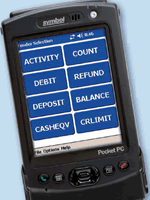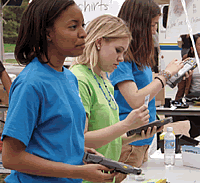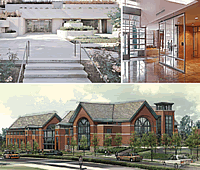Technology & Campus Services: The Changing Face of Auxiliary Services
As new needs crop up on campus, Auxiliary Services
finds solutions for mobile transactions, mountains
of junk mail, even green construction.

THE SEQUOIA: Retail Systems
Wireless
CampusCard Reader
allows transactions on the go.
Can auxiliary services be mission-critical? You bet
they can. With tuition on the rise, Auxiliary Services departments at
a variety of colleges and universities are proving that they can innovate
and still save their parent institutions cash. First in auxiliary
services innovation: With advancements in technology, a handful
of institutions are moving campus purchasing programs into the
wireless space. Second: With the proliferation of junk mail, learning
centers are finding new ways to eliminate paper waste and
improve efficiency across the board. Finally: As environmental
conservation becomes a bigger concern, schools are embracing
buildings that don’t harm the Earth, and many of the services
involved in those efforts make use of “green” approaches and
innovative technologies. Put simply, auxiliary services aren’t
so auxiliary anymore.
“Every dollar a school can save in terms of auxiliary services
means one less dollar in raised tuition,” says Bob Hassmiller,
executive director of the National Association of
College Auxiliary Services, an industry
organization based in Charlottesville, VA. “Meeting the
demands to give better service and charge more reasonable
rates for those services is what continues to put [auxiliary
services] in the forefront.”
Facilitating Mobility
Nobody understands these sentiments better than officials
at Duke University (NC), where officials sought to
enable students to use the DukeCard to complete transactions
via the Blackboard Transaction System at off-site locations such as athletic
events. For years, Duke’s campus card officials accomplished
this feat by stretching wires from the nearest
Ethernet port or by handling transactions with paper
receipts and reconciling them later. Finally, in 2003,
the team had had enough of this setup, and set out to
explore opportunities to utilize the school’s pervasive
wireless network to its advantage.
The quest for new technology began
when DukeCard programmers developed
a browser-based application that worked
on a number of mobile devices around
campus. The team presented the concept
at the annual Blackboard User’s Conference
in Baltimore, where it was received
with interest. Because the DukeCard
office wasn’t in a position to develop the
product, Blackboard partner Sequoia Retail Systems stepped in and integrated the browser
with the Sequoia Wireless Campus Card
Reader. Matthew Drummond, director of
the DukeCard office, says this device
changed the school’s entire approach virtually
overnight.
“As the success of the wireless transaction
has grown, more and more
demand has been put on us to provide
these services anytime, anywhere around
campus,” he says. Noting that the latest
card readers are no larger than a standard
personal digital assistant (PDA), he
adds, “This technology enables us to do
just that.”
Today, the devices, nearly 20 in all,
enable DukeCard officials to access user
activity and account privileges, process
debit and credit transactions, make
deposits, give refunds, and check balances—
all in real time over the wireless
network. The devices also can store
offline transactions, validate them against
a snapshot of the cardholder database,
and post them when it reconnects to the
network. Drummond says that since the
system was rolled out in late 2004, the
devices have cataloged more than 52,000
transactions totaling more than $350,000.
Last year, on a single Saturday with a
number of events, the DukeCard office
ran 12 different devices in six different
locations at the same time.
Drummond adds that his team also
uses the tools in more than 20,500 validation
transactions where proof of enrollment
is required. Case in point: the
annual iPod distribution. Every year, the
school doles out iPods to all incoming
freshmen. By using the wireless campus
card readers to scan student IDs, the
DukeCard office is able to ensure they are
giving devices only to eligible students.
This distribution procedure also has been
used for events where attendees had to
meet specific requirements such as yearbook
distribution, First Year picnic, and
Senior Night. According to Drummond,
the technology has made organizing these
outings easy.
“Previously, we accomplished this
kind of distribution with paper lists
from the registrar, and it was really
time-consuming to comb through all the
names to find the correct person,” says
Drummond. “Now, we just bring the
card readers, and that’s it.”

AT DUKE, wireless card scanners
have cataloged more than 52,000
transactions since late 2004.
Just about the only challenge Duke
has had with the devices is simply keeping
track of them. Over the course of the
2005-2006 school year, the DukeCard
Office used the mobile readers at more
than 350 events, making scheduling and
handoffs tricky. Earlier this year, the
team wrote a custom web application to
create a comprehensive snapshot of the
distribution schedule. The application
presents data in an overview like the
triage board in a hospital emergency
room, laying out which departments
have the readers and which are next in
line. So far, as a result of this application,
Drummond says the school hasn’t
lost a device. Considering they cost
$2,500 apiece, that’s a good thing.
Duke plans to expand the mobile card
reader project to include special cell
phones with readers built in. The
phones will process transactions on the
DukeCard system just like card readers
do, only they will do it over the Nextel cellular network that
covers the campus.
According to Drummond, a local
food-service delivery company tested
this technology in a pilot program earlier
this year, and was able to process
credit card payments instantaneously as
the food was exchanged. Down the road,
the program also will enable the university
to quickly settle outstanding bills
with local vendors and virtually eliminate
fraud. “With this technology, we
can help everybody—not just ourselves,”
he says. “I’m excited to see
where it g'es next.”
Eliminating Junk Mail
Environmentally conscious schools are
turning to auxiliary services to eliminate
one of the biggest sources of pollution
and waste: junk mail. Every day,
campus mailrooms are inundated with
the same barrage of catalogs, magazines,
newspapers, and collateral that
plague consumers. And according to
statistics from the US Postal Service, more than 66 percent
of these pieces have incomplete or
incorrect addresses, leaving universities
to determine what to do next. At many
schools, particularly the big ones, this
predicament can become a herculean
undertaking.
Innovative PDA-sized devices enable
DukeCard officials to access user activity
and account privileges, process debit and
credit transactions, make deposits, give
refunds, and check balances—all in real
time over the wireless network.
Yet, the problem of poor addressing
isn’t just about waste; it eats up manhours
as well. First, mailroom workers
must determine if the intended recipients
still attend the school. If the recipients
are in fact still enrolled, the
workers must take the time to look up
the right addresses and correct the
labels. Granted, misaddressed mail for
off-campus students is handled by the
local post office, which can reduce the
burden significantly. Still, according to
Aldona Robbins, CFO at Intra-Mail
Network, which specializes in helping schools with this
problem, the chore of redirecting and
delivering this mail on campus can tax
mailrooms to the point of inefficiency.
“There are schools that literally spend
days each week dealing with this,” says
Robbins, who notes that such schools as
the University of Houston (TX),
Georgetown University (DC), and
Washington University (MO) have
turned to her firm for help with their
junk-mail problems.
The solution focuses on ensuring
addresses are accurate before they ever
hit the campus mailroom. Senders transfer
their address data to Intra-Mail,
which uses proprietary software to
match address lists to unique campus
routing schemes, reducing undeliverable
campus addressing and expediting
delivery through campus mail centers.
The company also converts massive
unsorted commercial mail into presorted
bundles. Within each bundle, IntraMail numerically sequences the mail
according to a mail center’s delivery
route. By the time on-campus mail carriers
get the mail, it is accurate, sorted,
and ready for them to deliver—without
headaches.

GREEN SYSTEMS INNOVATION (clockwise, left to right):
At Carnegie Mellon, technology protects rare books; at
Penn State, lighting is conventionai and au naturel; at
University
of Vermont, ventilation systems go green.
Surprisingly, this service is free to
participating schools. It is the senders—
pharmaceutical companies, magazine
publishers, retail/wholesale catalog
companies and the like—that foot the
bill; they are more than willing to pay to
ensure that greater levels of their product
information reach their intended
audiences. Intra-Mail President Michael
Sanders says his firm actually pays colleges
a minimum of two cents for each
piece of mail it successfully delivers.
The economics behind the equation are
simple: The more schools Intra-Mail
can claim as customers, the more money
the company can charge senders for the
process of making sure their mailed
pieces go where they want them to go.
For the sender clients, and for higher
ed administrators, the benefits are
indisputable: “Would you rather have
1,000 pieces come in, 40 percent of
which are for people
who are no longer
there,” asks Sanders,
“or would you rather
have 600 pieces
come in, almost all
of them addressed
perfectly? For colleges that have grappled
with this problem for years, I’d say
the answer is pretty clear.”
Going Green
For Kermit the Frog, it’s not easy being
green. But across academia, colleges
and universities are finding it easier—
and more advantageous—than ever
before. In the world of higher education
as elsewhere, “green” refers to the adoption
of responsible environmental practices.
While this may not seem like a
traditional component of auxiliary services,
many officials say it’s part of an
overarching drive toward sustainability—
something
which
every Auxiliary
Services
department
should strive
for. In fact,
many “green” practices now fall under
the auspices of campus Auxiliary Services
departments, and many require the
intelligent use of technology. What’s
more, these efforts don’t just facilitate
conservation; they can save campus dollars
as well, lowering operational outlay
by saving energy costs, for instance.
Green programs are wide-ranging
and include efforts such as more effective
recycling, better management of energy consumption, and the implementation
of construction certified by
the US Green Building Council, the body that has established
worldwide standards (known as
the Leadership in Energy and Environmental
Design, or LEED, Green Building
Rating System) for this kind of
thing. In the state of Pennsylvania,
for instance, Pittsburgh-based WTW Architects has helped a number of colleges and
universities launch projects that fall into
the green category. Hank Colker, a principal
with the firm, says these efforts
are a “combination of common sense
and high technology,” and notes that a
sampling of their clients and projects
includes:
- Carnegie Mellon University, at which the new Posner Center features a “green” roof
(the roof space is “greened” by a full garden), as well as sophisticated
mechanical and lighting systems to protect the center’s rare book collections.
- Pennsylvania State University, where a new building in the School of Architecture and
Landscape Architecture showcases natural lighting (skylights, window walls,
etc.).
- California University of Pennsylvania, which is replacing some residence halls with new
facilities that have geothermal heating and cooling systems.
- Slippery Rock University, where a project to build seven new residence halls may be
one of the largest LEEDcertified student housing projects in the world.
- Indiana University of Pennsylvania,
where special contractors have been
hired to demolish out-of-date buildings
and recycle them as clean landfill.
Clean Up Your Act—and Monitor It
Outside of Pennsylvania, the University
of Vermont also has turned to WTW to
build a new, LEED-certified structure,
the Dudley H. Davis Student Center,
which will utilize local brick and slate
products and incorporate a “green” roof
over the loading dock. It will also boast
“smart” lighting systems that shut off
when a room is unoccupied, and natural
(not conventional air-condition/heat)
ventilation systems to save energy in
heating and cooling. Other planned
design features are intended to extend
environmental conservation even further—
there will be ample bike storage,
and every floor will have a full bathroom
with shower for cyclists who need to
freshen up, in the hopes that more students
will ride their bicycles to campus
and leave their cars at home.
University officials aren’t being bashful
about these advancements: The
school plans to construct the lobby
around a giant computer that will display
statistics on the building’s energy
consumption. The monitor will convey
how much water the new student center
is using, as well as how many carcinogens
and other pollutants it is pumping
into the atmosphere. Patty Eldred,
director of auxiliary services for the
school’s Administrative and Facility
Services department, says this computer
will be a great tool for learning, and
adds that perhaps the biggest benefit of
this construction is the school’s ability
to integrate sustainability into the curriculum
as a whole.
“We’ve always been a state that has
taken a look at the impact we create on
the environment,” she says. “This is a
good way to organize the way you live
your life, and we’re not only practicing
it, but we’ll teach it, too.”
WEBEXTRA :: Find out how schools are going “green”
with computerized energy management
systems, click here.
About the Author
Matt Villano is senior contributing editor of this publication.